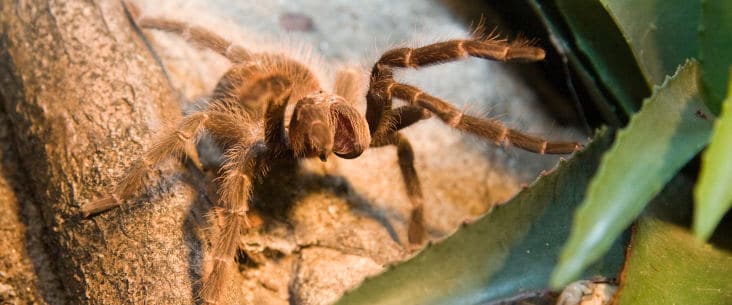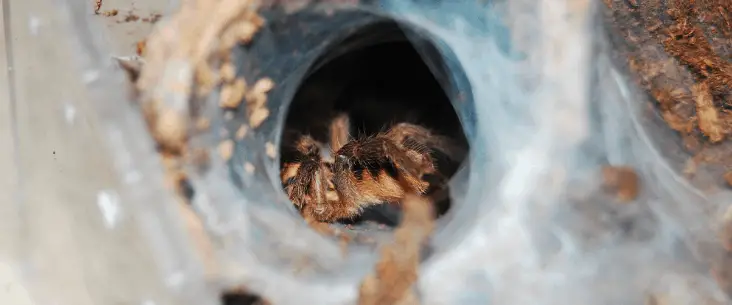Tarantulas are mysterious creatures. Most people are glad that they hide deep in the tropical forest and away from people. But because of its enormous size, you wonder what they predate and how they catch it. When you see tarantulas at the zoo or in someone’s home (hopefully inside a container), they most likely sit still and don’t do much. So, what do they hunt, and how do these massive spiders catch their prey? In this article, we take a closer look at the hunting behaviour of tarantulas.
Tarantulas are nocturnal hunters and most use a tactic to ambush prey that unawarely passes its burrow. They walk slow and deliberate towards their prey and at the last moment quickly strike, biting its prey by huge fangs injecting paralyzing venom. Tarantulas hunt insects, but some also catch myriapods, frogs & toads, small lizards, snakes or rodents.
However, different tarantulas have different hunting tactics. We will look at how these slow-moving spiders are successful hunters and how they catch their prey.
How do tarantulas hunt?
There is much mystery around the way tarantulas hunt and catch their prey. They live alone and a quiet life far away from the living world of people. But what not many people know is that they are quite extraordinary skilled hunters. Tarantulas feed entirely on other animals, mostly insects.
Tarantulas don’t make webs in trees, and bushes like many other spiders do, and therefore they need to leave the safety of their burrows and actively hunt for prey. First, tarantulas hunt mainly at night, and during the day, they will hide in their burrow. They like hunting in stealth mode and hunt by sneaking up or ambush their prey. They are not especially active hunters but rather wait for a chance when prey is close by.
Although tarantulas have multiple eyes, they have very poor eyesight (especially in the dark). However, they compensate it with a sense that is very well developed: Touch. To be more specific, they use vibration to detect prey. Their sensitive feed and body covered with 1000’s hairs will detect the slightest vibration. This sense is so fine-tuned they can exactly pinpoint where the vibration comes from and decide if it is worth a try.
When a tarantula is in close range, it can suddenly move striking fast, almost jump in one go, to catch its prey. They literally pounce on them. Quickly and firmly, they grab their prey with the pedipalps (legged-formed extensions), forelegs and crush the prey using their powerful mouthpart (chelicerae).
But that’s not all. While overtaking their prey, they quickly bite the prey with huge fangs and injecting venom that paralyzes and kills their victim. Although this sounds quite terrifying, the venom has a potency comparable to that of a bee. However, on such a small prey animal, it is much more effective.

Do tarantulas use webs to catch prey?
Tarantulas don’t make webs like the spiders in your backyard do, but they can make different types of webs. And they also use their ability to make silk lines to catch their prey, but not in a ‘traditional’ spider way.
Tarantulas use silk linings around their burrow as a tripwire to detect if the prey is close. We said it already before. Tarantulas are master in detecting vibration and use that to locate where possible prey is. If it is close enough and it doesn’t sense like danger, they will make an attempt to catch it.
The silk wires are not sticky and won’t hold or catch any prey. They are only used to create a field of tripwires to enlarge the field they can detect to alert them better that prey is close.
Do tarantulas eat their prey whole?
Yes, they eat their prey whole, but not in a way you might expect. They don’t chew off little pieces. Tarantulas don’t even have mouthparts to chew at all. Now, the way they eat is quite different.
When they catch their prey, they inject venom with their fangs. This not only paralyzes and kills the prey but also slowly digest and liquify their prey. Within the venom, there are special enzymes that break down its prey to an insect shake. They only have to suck it up.
The video below is a good example of how a tarantula catches its prey and use its pedipalps and fangs to restrain an unaware gecko while the spider slowly sucks it up. Be aware; it does not look tasty, so don’t look while you are eating!
Do tarantulas save or store food?
There is not much known about the behaviour of storing food by tarantulas. Tarantulas often attempt to catch most prey when it is nearby. You never know when the next meal comes by. No scientific report or study shows this behaviour or surviving strategy, but with some anecdotal observations is spotted that an earlier killed prey is eaten later on.
In captivity, it is more known that tarantulas will kill moving insects and eat them later. However, it can be that this is not normal because it is tough to mimic the natural food availability. Eventually, it is assumed that tarantulas know that food is steadily being fed. However, their instinct to kill moving prey is so strong that often it will kill a prey when it has the chance. Also, it is known that tarantulas eat more often in captivity what can result in obese spiders. Obesity with tarantulas is life-threatening because it causes difficulties when moulting. They can get literally get stuck in their old skin and won’t survive this event.
Keeping tarantulas as a pet!
Intrigued by the hunting behaviour of tarantulas. You can keep many species of tarantulas as a pet. They even are one of the best pet you can imagine. They don’t eat much, don’t need much space and cleaning, and are beautiful and interesting to see. Read here more about the basics of keeping tarantulas.
Share this page!


